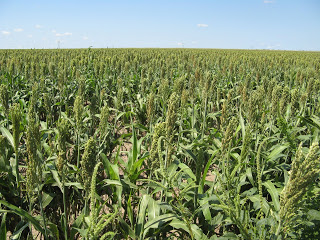 I spent the first three days of this week in Kansas on assignment visiting two nature preserves – one a native tallgrass prairie in eastern KS, and the other a restored prairie that was once a working ranch in western KS. Driving between the two, I passed acres upon acres of field crops…plenty of irrigated corn, some wheat and barley, as well as some hay. But there was another abundant crop that was previously unfamiliar to me: grain sorghum (also known as milo in some parts of the U.S.).
I spent the first three days of this week in Kansas on assignment visiting two nature preserves – one a native tallgrass prairie in eastern KS, and the other a restored prairie that was once a working ranch in western KS. Driving between the two, I passed acres upon acres of field crops…plenty of irrigated corn, some wheat and barley, as well as some hay. But there was another abundant crop that was previously unfamiliar to me: grain sorghum (also known as milo in some parts of the U.S.).
As gluten-free foodies, sorghum can be a staple of our diet…as flour used as a component in baking, as the base for GF beer, you name it. But how often do we make the connection to what this grain looks like in the field? Until I came face to face with it in Kansas, I certainly hadn’t.
Sorghum is common in Africa, and today is cultivated worldwide, especially in North America, South America, and Australia (beyond its original African scope). Because it’s a highly drought tolerant species, it grows especially well in places that are too dry for corn. That’s why the United States’ sorghum belt runs from Texas up into South Dakota…and straight through western Kansas where I saw it. (Kansas is in fact the top sorghum growing state in the nation.)
Depending on your source (such as the ag department at Purdue), anywhere from 7.7 to 18 million acres of sorghum are grown in the U.S. each year. There are five primary varieties, and while the field I photographed was young green sorghum, mature sorghum takes on beautiful colors ranging from golden tan to rusty red. According to the National Sorghum Producers, sorghum ranks as the fifth most important cereal crop in the world (behind rice, wheat, corn and barley). It’s used to feed animals, it’s used to make biofuels such as ethanol, and of course, it’s used to feed people. As a side environmental benefit, according to the USDA (as well as a Nature Conservancy wildlife biologist I met with in Kansas), sorghum has the highest wildlife value of any monoculture field grain crop.
The next time you’re sipping (or chugging) a RedBridge or baking with sorghum flour, hopefully you’ll have just a little deeper appreciation for this great grain of the gluten-free world. I know I do.
– Pete
Sorghum is grown around here all the time. We do refer to as milo, and unfortunately it’s a grain I don’t tolerate very well. It’s beautiful growing in the fields and helpful to many in gf flour mixes though. 🙂
Shirley
Hi Shirley… Sorry to hear you don’t tolerate it well. It was amazing (and beautiful) to see the variety of color in the mature plant. Gorgeous.
Cheers, Pete